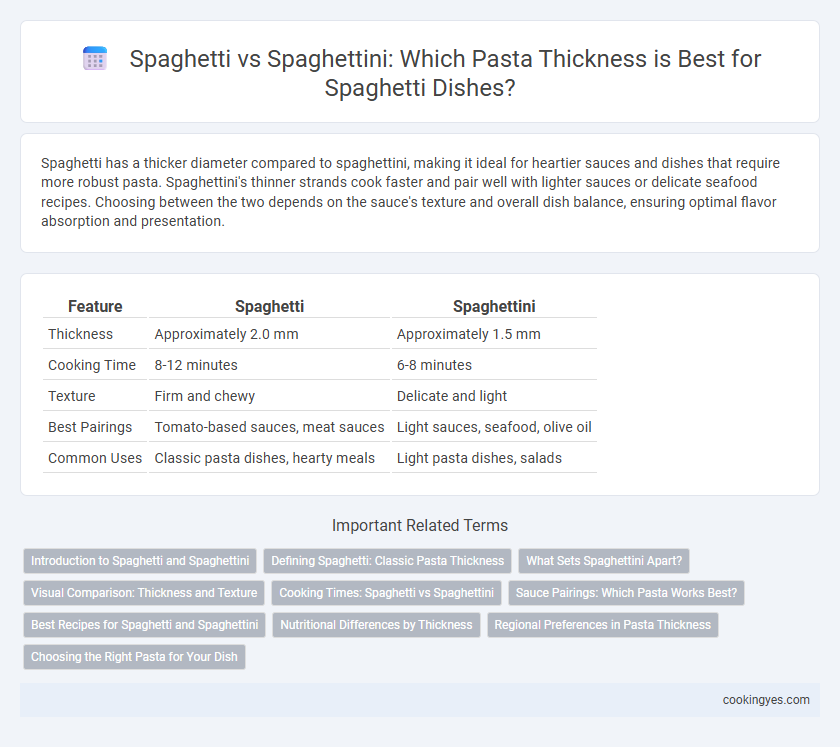Spaghetti has a thicker diameter compared to spaghettini, making it ideal for heartier sauces and dishes that require more robust pasta. Spaghettini's thinner strands cook faster and pair well with lighter sauces or delicate seafood recipes. Choosing between the two depends on the sauce's texture and overall dish balance, ensuring optimal flavor absorption and presentation.
Table of Comparison
| Feature | Spaghetti | Spaghettini |
|---|---|---|
| Thickness | Approximately 2.0 mm | Approximately 1.5 mm |
| Cooking Time | 8-12 minutes | 6-8 minutes |
| Texture | Firm and chewy | Delicate and light |
| Best Pairings | Tomato-based sauces, meat sauces | Light sauces, seafood, olive oil |
| Common Uses | Classic pasta dishes, hearty meals | Light pasta dishes, salads |
Introduction to Spaghetti and Spaghettini
Spaghetti typically measures about 2.0 millimeters in diameter, offering a hearty texture that holds up well to robust sauces like marinara or Bolognese. Spaghettini is thinner, usually around 1.4 millimeters, providing a lighter bite that pairs perfectly with delicate sauces such as garlic and olive oil or seafood-based dressings. Both pasta types originate from Italian cuisine and serve distinct culinary purposes based on their thickness and sauce compatibility.
Defining Spaghetti: Classic Pasta Thickness
Spaghetti typically measures about 1.8 to 2 millimeters in diameter, making it a classic pasta thickness ideal for a wide range of sauces from marinara to carbonara. In contrast, spaghettini is thinner, usually around 1.3 to 1.5 millimeters, offering a more delicate texture that pairs well with lighter sauces or seafood. Understanding these subtle differences helps chefs and home cooks choose the perfect pasta for their dish's desired texture and sauce adherence.
What Sets Spaghettini Apart?
Spaghettini is distinguished by its thinner diameter, typically measuring around 1.5 millimeters compared to spaghetti's 2 millimeters, resulting in a more delicate texture that cooks faster and pairs well with light sauces or seafood. This subtle difference in thickness affects the pasta's surface area, enhancing sauce adherence and creating a refined mouthfeel. Chefs often choose spaghettini for dishes requiring a gentle pasta base that complements rather than overpowers subtle flavors.
Visual Comparison: Thickness and Texture
Spaghetti typically measures about 2.0 mm in diameter, offering a thicker and more robust texture that holds sauce well, while spaghettini is thinner, around 1.5 mm, providing a delicate, lighter bite with a subtly smoother surface. The increased thickness of spaghetti results in a more substantial mouthfeel and a slightly chewier texture, making it ideal for heartier sauces such as Bolognese or marinara. Spaghettini's slender form allows for quicker cooking times and a more refined presentation, often paired with lighter, oil-based sauces or seafood.
Cooking Times: Spaghetti vs Spaghettini
Spaghetti typically measures around 2 millimeters in diameter and requires a cooking time of 8 to 12 minutes to reach al dente texture. Spaghettini, being thinner at approximately 1.5 millimeters, cooks faster, usually in 5 to 7 minutes, making it ideal for light sauces. Adjusting cooking times based on thickness ensures optimal texture and taste in pasta dishes.
Sauce Pairings: Which Pasta Works Best?
Spaghetti, with its thicker strands, holds up well to heartier sauces like marinara or Bolognese, providing a balanced bite with rich, chunky textures. Spaghettini, thinner and more delicate, is ideal for lighter sauces such as aglio e olio or simple tomato and basil, allowing the subtle flavors to shine without overwhelming the pasta. Choosing between spaghetti and spaghettini depends on sauce viscosity and flavor intensity to achieve optimal taste harmony.
Best Recipes for Spaghetti and Spaghettini
Spaghetti, with a thickness of approximately 2 mm, is ideal for robust sauces like marinara or Bolognese, enhancing recipes such as classic spaghetti carbonara or spaghetti aglio e olio. Spaghettini, thinner at around 1.5 mm, pairs best with lighter sauces like seafood or olive oil-based dishes, making it perfect for recipes like lemon garlic shrimp spaghettini or simple tomato basil. Choosing between spaghetti and spaghettini significantly impacts texture and sauce absorption, directly influencing the dish's flavor profile and overall dining experience.
Nutritional Differences by Thickness
Spaghetti and spaghettini differ primarily in thickness, with spaghetti typically measuring about 2 mm in diameter and spaghettini being thinner, around 1.5 mm. The thickness influences cooking time and texture, but nutritional differences are minimal, as both share similar calorie, carbohydrate, and protein content per serving. Slight variations may occur due to water absorption during cooking, yet overall macronutrient profiles remain consistent between spaghetti and spaghettini.
Regional Preferences in Pasta Thickness
Spaghetti, typically 1.8 to 2 mm in diameter, is favored in southern Italy for its balanced texture that holds sauces well, while spaghettini, measuring around 1.3 mm, is preferred in northern regions for lighter, more delicate dishes. The thinner spaghettini pairs excellently with subtle seafood or olive oil-based sauces, reflecting northern Italy's emphasis on refined, lighter flavors. Regional culinary traditions influence these preferences, with southern Italian cuisine often favoring heartier pasta shapes like spaghetti to complement robust tomato or meat sauces.
Choosing the Right Pasta for Your Dish
Spaghetti typically measures about 2.0 mm in diameter, making it thicker and heartier, while spaghettini is thinner at approximately 1.5 mm, offering a more delicate texture. Thicker spaghetti pairs well with robust sauces like Bolognese or marinara, providing a satisfying bite that holds up to rich flavors. In contrast, spaghettini complements lighter sauces such as olive oil, garlic, or seafood, allowing subtle tastes to shine without overwhelming the palate.
Spaghetti vs Spaghettini for pasta thickness Infographic

 cookingyes.com
cookingyes.com